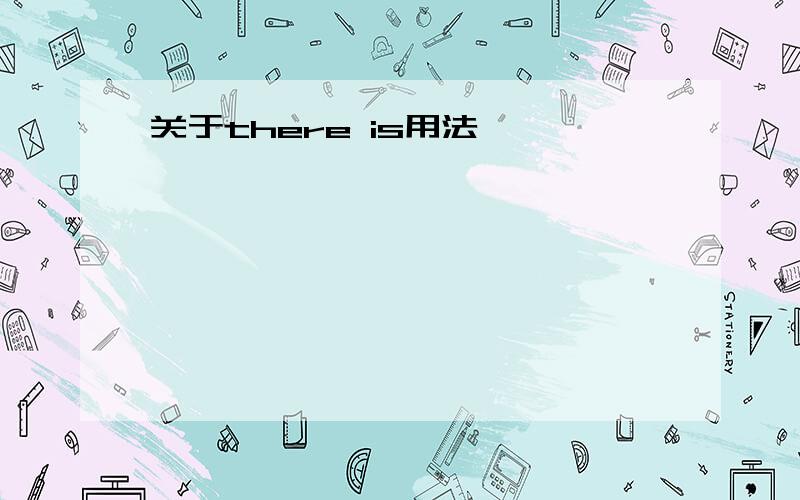关于there is用法,
来源:学生作业帮助网 编辑:作业帮 时间:2024/11/25 05:17:32

关于there is用法,
关于there is用法,
关于there is用法,
There be 句型是一常见的表示“存在”的句型.该结构不表示“存在”意义的现象又广见于书面语及口语,它以否定There be + sth + 地点状语
There is a flower in the bottle. 瓶里有一朵花. There is some money in the purse. 钱包里有些钱.
There be + no + n. + in doing sth
1.其中名词为表“利弊”、“用途”的抽象名词,如: There is no good in going. 去没有什么好处. There is no harm in doing that. 那样做并无害处. There is no use in doing it. 干此事毫无用处. 2.其中名词为表“价值”、“意义”的抽象名词,如: There is no sense in waiting here. 在这里等候下去毫无意义. There is no point in doing so. 这样做毫无意义. There is no disgrace in failing once. 一旦失败也不丢脸. (注:此结构中的介词可以省略,如:There is no use asking her—she doesn’t know anything.)
There is + no + doing something
1.其中的动词(do)多为“转述”或“认知”等意义的动词,如:tell, say, know等,其后一般跟疑问句,如when,what等. There is no saying what may happen. 很难说会发生什么事. There is no telling when he will return. 说不清他何时回来. There is no knowing when we shall meet again. 不知何时我们能再相会. 2.其他动词,其意义相当灵活. There is no mistaking what ought to be done. 应该做什么是清楚的. There is no denying the fact. 事实无可否认. There is no holding back the wheel of history. 历史的车轮不能倒转. There is no getting along with him. 他很难相处. Once she starts talking, there is no stopping her. 一旦她打开话匣子,就说个没完. There is no joking with him. 和他不能开玩笑.
There is + no + Action Noun
1.此结构的含义相当于It’s impossible /unnecessary to do something. There is no hurry about it. 没有必要这么急匆匆的. There is no question of his honesty. 他的诚实是勿庸置疑的. 2.有时,在此结构中的Action Noun被动名词形式所取代,其意义不变.: There is no escape from the evident. There is no escaping the fact. 两句都表示:无法逃(躲)避…… 但是,有时也存在意义上的区别, There is no doubt at all about it. There is no doubting her virtue. 句a为“存在句”,意即:对于此事不存在任何的疑问. 句b则是不表“存在”的一种惯用结构,意即:她的贞操勿庸置疑. 3.以上三种结构除用于陈述句外,尚可见于疑问句.如: Is there any use in discussing the matter further? 这种事再讨论下去有何益处? Is there any hurry about it? 这事需要匆忙吗? 此惯用结构中的be有时可与情态动词连用,其语气更趋委婉.如: There could be no mistaking where he had come from. 他从哪里来是相当清楚的. 此结构中的no也不是一成不变的,它可被其他形式所取代.如: There isn’t any getting away from it. 要从它那里逃脱是不可能的. There was never believing half of what he said. 他的话连一半也不信. There’s never any predicting what they will do next. 无法料及他们下一步将会干什么
编辑本段There be结构中的be动词的确定
1. there be 结构中的谓语动词be在人称和数上应与其后的主语保持一致.主语是不可数名词或单数可数名词时用is,是复数时用are.如: There is a flower in the bottle. 瓶里有一朵花. There is some money in the purse. 钱包里有些钱. 2. 若句子中有几个并列的主语时,be的形式要与离其最近的一个主语在人称和数上保持一致.如: There is a boy, a girl and two women in the house. 房子里有一个男孩,一个女孩和两个妇女. There are ten students and a teacher in the office. 办公室里有十个学生和一个教师. 3. 另外,在陈述句中为了强调地点,也可将介词短语提置句首.如: In the tree there are five birds. 树上有五只鸟.
编辑本段There be 结构的句型转换
否定句
there be的否定式通常在be后加not构成(在口语中be时常与not缩写在一起).如果句中有some,一般要变成any.如: There are some children in the picture. →There aren't any children in the picture.
一般疑问句及其答语
把be提到there前,首字母大写,句末用问号即可.其肯定答语是Yes, there is / are;否定答语为No, there isn't / aren't.如: —Are there two cats in the tree? —Yes, there are. (No, there aren't.)
特殊疑问句及其回答
①提问句子的主语(包括主语前的修饰语)时,句型一律用"what is + 地点介词短语?"(无论主语是单数还是复数都用is).如: There are some birds in the tree. →What's in the tree? ②就there be后面的地点状语进行提问时,句型用"where is / are + 主语?"如: There is a car in the street. →Where is the car? ③提问可数名词(主语)前的数量时,用how many,句型结构为"how many + 复数名词 + are there + 其它?"(主语无论是单数还是复数,be通常要用are).
编辑本段相关
注意
当there be后面的名词时单数或不可数名词时be用is,当后面是可数名词复数时,be用are. “there be...”句型是存在句的常用基本结构,there在句中处于主语位置,起形式主语的作用,真正的主语是随后的名词词组.其谓语动词通常是be的各种时、体等形式.如: There is ice on the lake. 湖上有冰. There were three students in the classroom then. 当时教室有三个学生. There has never been anybody like you. 从来还没有像你这样的人. There will be snow on high ground.在高地上将会有雪. 除此之外, there be句型还有一些特殊的结构: 1. there + 情态助动词 + be表示 “预见”、“可能”、“必然”或“过去习惯存在”等.如: There might be some desserts if you wait a bit. 如果你等一会儿,可能会有甜点. There ought to have been someone on duty all the time. 本来应该有人全天值班. There shall be no more wars. 再也不会打仗了. 也可以用there + 某些半助动词 + be(很少使用完成体形式),如:be going to, be certain to, be sure to, be likely to, have to be等. There is going to be a rain. 要下雨了. There's likely to be an interview.可能会有一场面试. There has to be a mistake. 必定有错. 2. 在正式文体中,某些表示存在、发生、出现、坐落等意义的不及物动词也可以与there连用,如:appear, seem, come, remain, exist, live, stand, lie, arise, enter, follow, occur, rise, grow, happen, belong, arrive, fly, flash, sail, pass, run, spring up, emerge等.如: There exist many ancient temples in the country. 那个国家有很多古老的寺庙. There lies a small village in the mountain.山里有个小村子. Once upon a time, there lived an old queer man in the city. 从前,城里住着个怪老头. There remains nothing more to be done. 没有什么别的事可做了. There followed the first world war. 接着就是第一次世界大战. There flashed through his mind the image of a heroic fighter.他的头脑中闪过英雄战士的形象. There sprang up a wild gale.突然刮起一阵狂风. 偶尔也能见到there后接及物动词: There struck me a sudden idea. 突然我有了一个主意. 如果句中的地点状语前移就可以省略there. 如: Behind the house (there) is a small river. 3. there + 不定式to be 或there + being形式,称为非限定存在句,可以作主语、宾语、介词补足成分. 1) 作主语 There being a railway station in the town is a great advantage. 镇上有个火车站,真方便呀! “there to be+NP”作主语时,通常用for作引导词: For there to be a mistake in a computer's arithmetic is impossible. 计算机计算错误是不可能的. It was seldom for there to be no late comers. 新来者很少没有迟到的. 2) 作宾语 The committee anticipated there being less debate in the second discussion. 委员会期望在第二次讨论中争议能少一些. We expect there to be no objections. 我们希望不会有人反对. I'd prefer there to be more cooperation. 我希望有更多的合作. 3) 作介词补足成分 介词是for, 用there to be形式;介词不是for,则用there being形式. What's the chance of there being an election this year?今年进行选举的可能性有多大? We have no objection to there being a meeting here. 在这儿举行会议,我们不反对. Jill is waiting for there to be a big party.吉尔等着举行一次盛大的晚会. 此外,there + being形式还可以用作状语分句,形成独立主格结构: There being no further discussion, the chairman stood up and left the meeting-room.没有可讨论的了,主席站了起来,离开了会议室. There having been no rain,the stream was dry. 一直没有下雨,小溪都干涸了.
句式分辨
“there be...”句型的难点在于它的非限定形式, 怎样分辨使用there to be 和there being 呢? 两个要点是关键:它们在句子中的成分及与句子中其他成分的搭配关系.如非限定形式的第2小点中的例句:anticipate与there being搭配,而expect 和prefer与there to be配伍.句的形式出现,用于对某一具体行为和抽象概念的否定.
there be 句型表示某地有某物。和have拥有(一般指人拥有什么东西)要区分开。
there be 一般用在There be + sth + 地点状语这个句型里。
例如:there are so many flowers in the garden。
there be 句型的就近原则,be 用is 还是are 要看这后面紧跟的那件物品是单数还是复数,如果是单数就用is...
全部展开
there be 句型表示某地有某物。和have拥有(一般指人拥有什么东西)要区分开。
there be 一般用在There be + sth + 地点状语这个句型里。
例如:there are so many flowers in the garden。
there be 句型的就近原则,be 用is 还是are 要看这后面紧跟的那件物品是单数还是复数,如果是单数就用is ,如果是复数就用are,当然如果是不可数名词就用is了。不管后面跟多少物品,就看第一个的物品的单复数。比如:There is a pen,two books and a bag on the desk。
收起